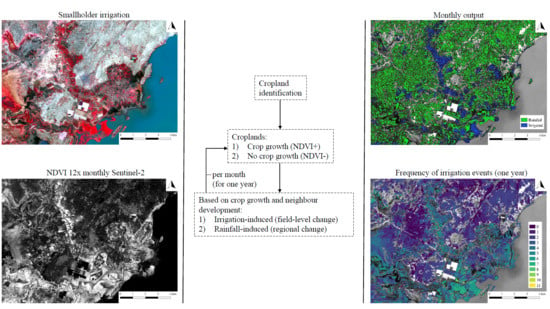Spatio-Temporal Patterns of Smallholder Irrigated Agriculture in the Horn of Africa Using GEOBIA and Sentinel-2 Imagery
Abstract
1. Introduction
2. Data and Methods
2.1. Data Collection and Preprocessing through the Google Earth Engine
2.2. Workflow of Mapping Irrigated Agriculture
2.2.1. Segmentation
2.2.2. Training and Validation Data
2.2.3. Cropland Classification
2.2.4. Irrigation Classification
3. Results
3.1. Irrigation Classification
3.2. Quality of the Maps
3.2.1. Delineation of Croplands
3.2.2. Validation of Cropland Classification
4. Discussion
4.1. Comparison of Irrigation Maps with Other Products
4.2. Quality of the Irrigation Maps
4.3. Applicability of the Method and Irrigation Maps
5. Conclusions
Supplementary Materials
Author Contributions
Funding
Conflicts of Interest
References
- Pricope, N.G.; Husak, G.; Lopez-carr, D.; Funk, C.; Michaelsen, J. The climate-population nexus in the East African Horn: Emerging degradation trends in rangeland and pastoral livelihood zones. Glob. Environ. Chang. 2013, 23, 1525–1541. [Google Scholar] [CrossRef]
- Sidahmed, A. Recent trends in drylands and future scope for advancement. In Climate Variability Impacts on Land Use and Livelihoods in Drylands; Gaur, M., Squires, V., Eds.; Springer International Publishing AG: Cham, Switzerland, 2018; p. 32. [Google Scholar]
- FAO. Horn of Africa Cross-Border Drought Action Plan 2017; Food and Agriculture Organization of the United Nations: Rome, Italy, 2017. [Google Scholar]
- Funk, C.C.; Brown, M.E. Declining global per capita agricultural production and warming oceans threaten food security. Food Secur. 2009, 1, 271–289. [Google Scholar] [CrossRef]
- Thornton, P.K.; Jones, P.G.; Alagarswamy, G.; Andresen, J. Spatial variation of crop yield response to climate change in East Africa. Glob. Environ. Chang. 2009, 19, 54–65. [Google Scholar] [CrossRef]
- Salami, A.; Kamara, A.B.; Brixiova, Z. Smallholder Agriculture in East Africa: Trends, Constraints and Opportunities; Technical Report; African Development Bank: Tunis, Tunisia, 2010. [Google Scholar]
- Rockström, J. Water resources management in smallholder farms in Eastern and Southern Africa: An overview. Phys. Chem. Earth Part B Hydrol. Oceans Atmos. 2000, 25, 275–283. [Google Scholar] [CrossRef]
- Abate, T.; Van Huis, A.; Ampofo, J.K.O. Pest management strategies in traditional agriculture: An African perspective. Annu. Rev. Entomol. 2000, 45, 631–659. [Google Scholar] [CrossRef] [PubMed]
- Hansen, J.W.; Mason, S.J.; Sun, L.; Tall, A. Review of seasonal climate forecasting for agriculture in sub-saharan Africa. Exp. Agric. 2011, 47, 205–240. [Google Scholar] [CrossRef]
- Oya, T.; Inada, K.; Tsutsui, Y.; Lemma, G.; Kebebew, B.; Suzuki, S.; Takahashi, S. Trial on supplemental irrigation technology during rainy season in semi-arid area of Ethiopia. J. Arid Land Stud. 2012, 22, 211–214. [Google Scholar]
- Lebdi, F. Irrigation for Agricultural Transformation; Technical Report; African Center for Economic Transformation (ACET) and Japan International Cooperation Agency Research Institute (JICA-RI): Accra, Ghana, 2016. [Google Scholar]
- USGS. Irrigation Water Use: Surface Irrigation. 2016. Available online: https://water.usgs.gov/edu/irfurrow.html (accessed on 12 September 2017).
- FAO. Economic Valuation of Water Resources in Agriculture: From the Sectoral to a Functional Perspective of Natural Resource Management; Water Reports No. 27; Food and Agriculture Organization of the United Nations: Rome, Italy, 2004. [Google Scholar]
- IAC. Realizing the Promise and Potential of African Agriculture: Implementation of Recommendations and Action Agenda; InterAcademy Council: Amserdam, The Netherlands, 2004. [Google Scholar]
- World Bank. World Development Report 2008: Agriculture for Development; World Bank: Washington, DC, USA, 2008. [Google Scholar]
- Tschirley, D. What Is the Scope for Horticulture to Drive Smallholder Poverty Reduction in Africa? Policy Synthesis; Technical Report; USAID, University of Michigan: Ann Arbor, MI, USA, 2011. [Google Scholar]
- Burney, J.A.; Naylor, R.L. Smallholder Irrigation as a Poverty Alleviation Tool in Sub-Saharan Africa. World Dev. 2012, 40, 110–123. [Google Scholar] [CrossRef]
- Beekman, W.; Veldwisch, G.J.; Bolding, A. Identifying the potential for irrigation development in Mozambique: Capitalizing on the drivers behind farmer-led irrigation expansion. Phys. Chem. Earth Parts A/B/C 2014, 76–78, 54–63. [Google Scholar] [CrossRef]
- Siddiqui, S.; Cai, X.; Chandrasekharan, K. Irrigated Area Map Asia and Africa (International Water Management Institute). 2018. Available online: http://waterdata.iwmi.org/applications/irri{_}area/ (accessed on 8 May 2018).
- Siebert, S.; Henrich, V.; Frenken, K.; Burke, J. Update of the Digital Global Map of Irrigation Areas to Version 5; Technical Report; Institute of Crop Science and Resource Conservation Rheinische Friedrich- Wilhelms-Universität: Bonn, Germany, 2013. [Google Scholar]
- Thenkabail, P.S.; Biradar, C.M.; Noojipady, P.; Dheeravath, V.; Li, Y.; Velpuri, M.; Gumma, M.; Gangalakunta, O.R.P.; Turral, H.; Cai, X.; et al. Global irrigated area map (GIAM), derived from remote sensing, for the end of the last millennium. Int. J. Remote Sens. 2009, 30, 3679–3733. [Google Scholar] [CrossRef]
- Bégué, A.; Arvor, D.; Bellon, B.; Betbeder, J.; De Abelleyra, D.; Ferraz, R.P.D.; Lebourgeois, V.; Lelong, C.; Simões, M.; Verón, S.R. Remote sensing and cropping practices: A review. Remote Sens. 2018, 10, 99. [Google Scholar] [CrossRef]
- Ozdogan, M.; Yang, Y.; Allez, G.; Cervantes, C. Remote sensing of irrigated agriculture: Opportunities and challenges. Remote Sens. 2010, 2, 2274–2304. [Google Scholar] [CrossRef]
- Velpuri, N.M.; Thenkabail, P.S.; Gumma, M.K.; Biradar, C.; Dheeravath, V.; Noojipady, P.; Yuanjie, L. Influence of resolution in irrigated area mapping and area estimation. Photogramm. Eng. Remote Sens. 2009, 75, 1383–1395. [Google Scholar] [CrossRef]
- Blaschke, T.; Hay, G.J.; Kelly, M.; Lang, S.; Hofmann, P.; Addink, E.; Queiroz Feitosa, R.; Van der Meer, F.; Van der Werff, H.; Van Coillie, F.; et al. Geographic Object-Based Image Analysis—Towards a new paradigm. ISPRS J. Photogramm. Remote Sens. 2014, 87, 180–191. [Google Scholar] [CrossRef] [PubMed]
- Xiong, J.; Thenkabail, P.S.; Tilton, J.C.; Gumma, M.K.; Teluguntla, P.; Oliphant, A.; Congalton, R.G.; Yadav, K.; Gorelick, N. Nominal 30-m cropland extent map of continental Africa by integrating pixel-based and object-based algorithms using Sentinel-2 and Landsat-8 data on Google Earth Engine. Remote Sens. 2017, 9, 1065. [Google Scholar] [CrossRef]
- Lebourgeois, V.; Dupuy, S.; Vintrou, É.; Ameline, M.; Butler, S.; Bégué, A. A combined random forest and OBIA classification scheme for mapping smallholder agriculture at different nomenclature levels using multisource data (simulated Sentinel-2 time series, VHRS and DEM). Remote Sens. 2017, 9, 259. [Google Scholar] [CrossRef]
- Lambert, M.J.; Sibiry Traore, P.C.; Blaes, X.; Baret, P.; Defourny, P. Remote Sensing of Environment Estimating smallholder crops production at village level from Sentinel-2 time series in Mali’s cotton belt. Remote Sens. Environ. 2018, 216, 647–657. [Google Scholar] [CrossRef]
- Vogels, M.; Addink, E.; Sterk, G.; Jong, S. Mapping irrigated agriculture in complex landscapes using SPOT6 imagery and object-based image analysis—A case study in the Central Rift Valley, Ethiopia. Int. J. Appl. Earth Obs. Geoinf. 2019, 19, 118–229. [Google Scholar] [CrossRef]
- Al-Bakri, J.T.; Suleiman, A.S. NDVI response to rainfall in different ecological zones in Jordan. Int. J. Remote Sens. 2004, 25, 3897–3912. [Google Scholar] [CrossRef]
- FEWSNET. Illustrating the Extent and Severity of the 2016/17 Horn of Africa Drought; Technical Report; Famine Early Warning Systems Network. 2017. Available online: https://fews.net/sites/default/files/documents/reports/FEWS_NET_Horn_of_Africa_June%202017_Drought_Map_Book.pdf (accessed on 29 December 2018).
- Google Earth Engine Team. Google Earth Engine: A Planetary-Scale Geo-Spatial Analysis Platform. 2017. [Google Scholar]
- Nicholson, S.E. Climate and climatic variability of rainfall over eastern Africa. Rev. Geophys. 2017, 55, 590–635. [Google Scholar] [CrossRef]
- Trimble. eCognition Developer 9.3 Reference Book; Trimble Germany Documentation: Munchen, Germany, 2017. [Google Scholar]
- Baatz, M.; Schäpe, A. Multiresolution Segmentation: An Optimization Approach for High Quality Multi-Scale Image Segmentation; Angew. Geogr. Info. Verarbeitung; Wichmann-Verlag: Heidelberg, Germany, 2000; pp. 12–23. [Google Scholar]
- ESRI. ArcGIS Online Standard Service: World Imagery Collection, Map Server. Maps Throughout This Book Were Created Using ArcGIS® Software by ESRI. ArcGIS® and ArcMapTM Are the Intellectual Property of ESRI and Are Used Herein under License, Copyright ©ESRI. 2018. Available online: https://www.arcgis.com/index.html (accessed on 7 February 2018).
- Google Maps. 2017. Available online: https://www.google.nl/maps/place/Metehara (accessed on 7 June 2018).
- Breiman, L. Random forests. Mach. Learn. 2001, 45, 5–32. [Google Scholar] [CrossRef]
- Liaw, A.; Wiener, M. Classification and Regression by randomForest. R News 2002, 2, 18–22. [Google Scholar] [CrossRef]
- R Development Core Team. R: A Language and Environment for Statistical Computing; R Foundation for Statistical Computing: Vienna, Austria, 2017. [Google Scholar]
- Lillesand, T.; Kiefer, R.; Chipman, J. Remote Sensing and Image Interpretation, 6th ed.; John Wiley & Sons: New York, NY, USA, 2015; p. 483. [Google Scholar]
- Funk, C.; Peterson, P.; Landsfeld, M.; Pedreros, D.; Verdin, J.; Shukla, S.; Husak, G.; Rowland, J.; Harrison, L.; Hoell, A.; Michaelsen, J. The climate hazards infrared precipitation with stations—A new environmental record for monitoring extremes. Sci. Data 2015, 2. [Google Scholar] [CrossRef] [PubMed]
- Chen, J.; Chen, J.; Liao, A.; Cao, X.; Chen, L.; Chen, X.; He, C.; Han, G.; Peng, S.; Lu, M.; et al. Global land cover mapping at 30 m resolution: A POK-based operational approach. ISPRS J. Photogramm. Remote Sens. 2015, 103, 7–27. [Google Scholar] [CrossRef]
- Xiong, J.; Thenkabail, P.S.; Gumma, M.K.; Teluguntla, P.; Poehnelt, J.; Congalton, R.G.; Yadav, K.; Thau, D. Automated cropland mapping of continental Africa using Google Earth Engine cloud computing. ISPRS J. Photogramm. Remote Sens. 2017, 126, 225–244. [Google Scholar] [CrossRef]
- Arino, O.; Gross, D.; Ranera, F.; Leroy, M.; Bicheron, P.; Brockman, C.; Defourny, P.; Vancutsem, C.; Achard, F. GlobCover: ESA service for global land cover from MERIS. In Proceedings of the IEEE International Geoscience and Remote Sensing Symposium, Barcelona, Spain, 23–27 July 2007; pp. 2412–2415. [Google Scholar]
- Salmon, J.M.; Friedl, M.A.; Frolking, S.; Wisser, D.; Douglas, E.M. Global rain-fed, irrigated, and paddy croplands: A new high resolution map derived from remote sensing, crop inventories and climate data. Int. J. Appl. Earth Obs. Geoinf. 2015, 38, 321–334. [Google Scholar] [CrossRef]
- Teluguntla, P.; Thenkabail, P.S.; Xiong, J.; Gumma, M.K.; Giri, C.; Milesi, C.; Ozdogan, M.; Congalton, R.G.; Tilton, J.; Sankey, T.T.; et al. Global Food Security Support Analysis Data at nominal 1 km (GFSAD1km) derived from remote sensing in support of food security in the twenty-first century: current achievements and future possibilities. In Remote Sensing Handbook (Volume II): Land Resources Monitoring, Modeling, and Mapping with Remote Sensing; Thenkabail, P., Ed.; CRC Press: Boca Raton, FL, USA, 2015; pp. 131–160. [Google Scholar]
- FAO. AQUASTAT Main Database, Food and Agriculture Organization of the United Nations. 2016. Available online: http://www.fao.org/nr/water/aquastat/main/index.stm (accessed on 10 October 2018).
- Abuzar, M.; McAllister, A.; Whitfield, D. Mapping irrigated farmlands using vegetation and thermal thresholds derived from Landsat and ASTER data in an irrigation district of Australia. Photogramm. Eng. Remote Sens. 2015, 81, 229–238. [Google Scholar] [CrossRef]
- Steenbergen, F.V.; Mehari, A.; Alemehayu, T.; Alamirew, T.; Geleta, Y. Status and potential of spate irrigation in Ethiopia. Water Resour. Manag. 2011, 25, 1899–1913. [Google Scholar] [CrossRef]
- Dejen, Z.A. Hydraulic and Operational Performance of Irrigation System in View of Interventions for Water Saving and Sustainability. Ph.D. Thesis, UNESCO-IHE Institute for Water Education, Delft, The Netherlands, 2014. [Google Scholar]
- Loveland, T.R.; Reed, B.C.; Brown, J.F.; Ohlen, D.O.; Zhu, Z.; Yang, L.; Merchant, J.W. Development of a global land cover characteristics database and IGBP DISCover from 1 km AVHRR data. Int. J. Remote Sens. 2000, 21, 1303–1330. [Google Scholar] [CrossRef]
- Demissie, A.; Abraham, C.; Haile, M.; Schultz, B. Optimum irrigation and pond operation to move away from exclusively rainfed agriculture: the Boru Dodota spate irrigation scheme, Ethiopia. Irrig. Sci. 2013, 31, 1091–1102. [Google Scholar] [CrossRef]
- DCP. Degree Confluence Project: Organized Sampling of the Entire World at Every 1u Latitude and 1u Longitude Intersection. 2018. Available online: http://confluence.org/ (accessed on 15 October 2018).
- GFSAD. Global Food Security Support Analysis Data (GFSAD) Project Validation Dataset. 2018. Available online: https://croplands.org/app/data/search (accessed on 1 August 2018).
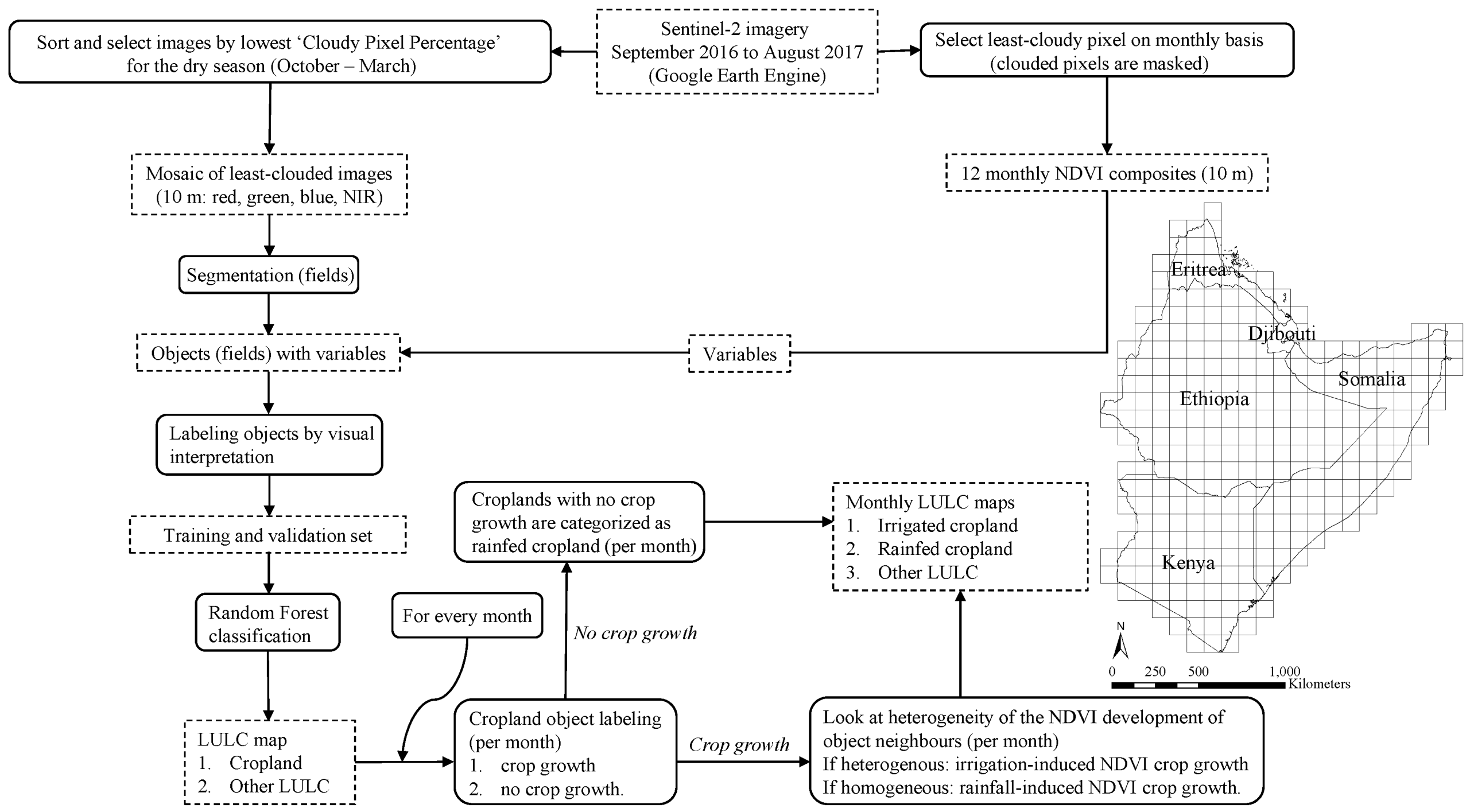
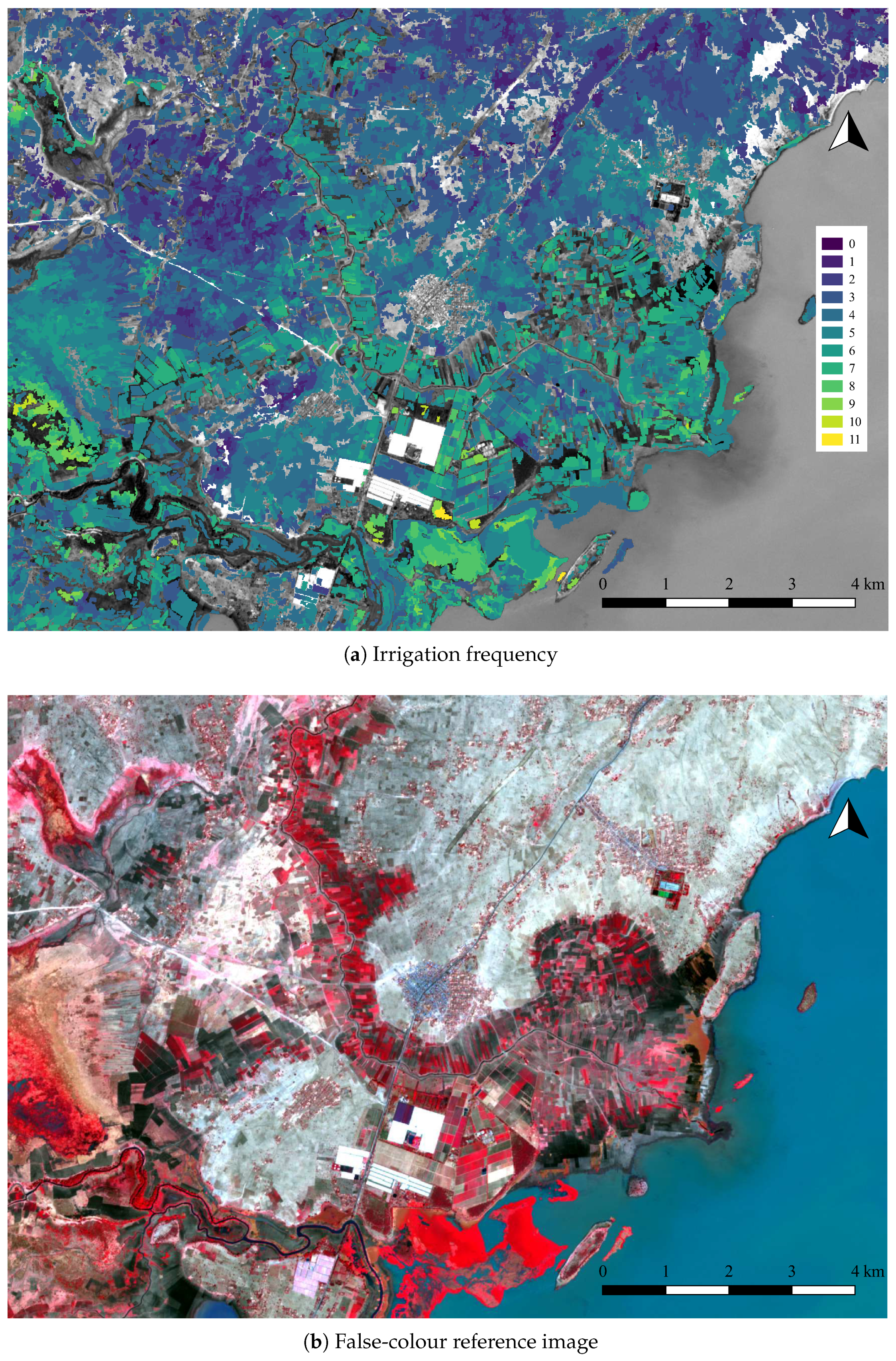
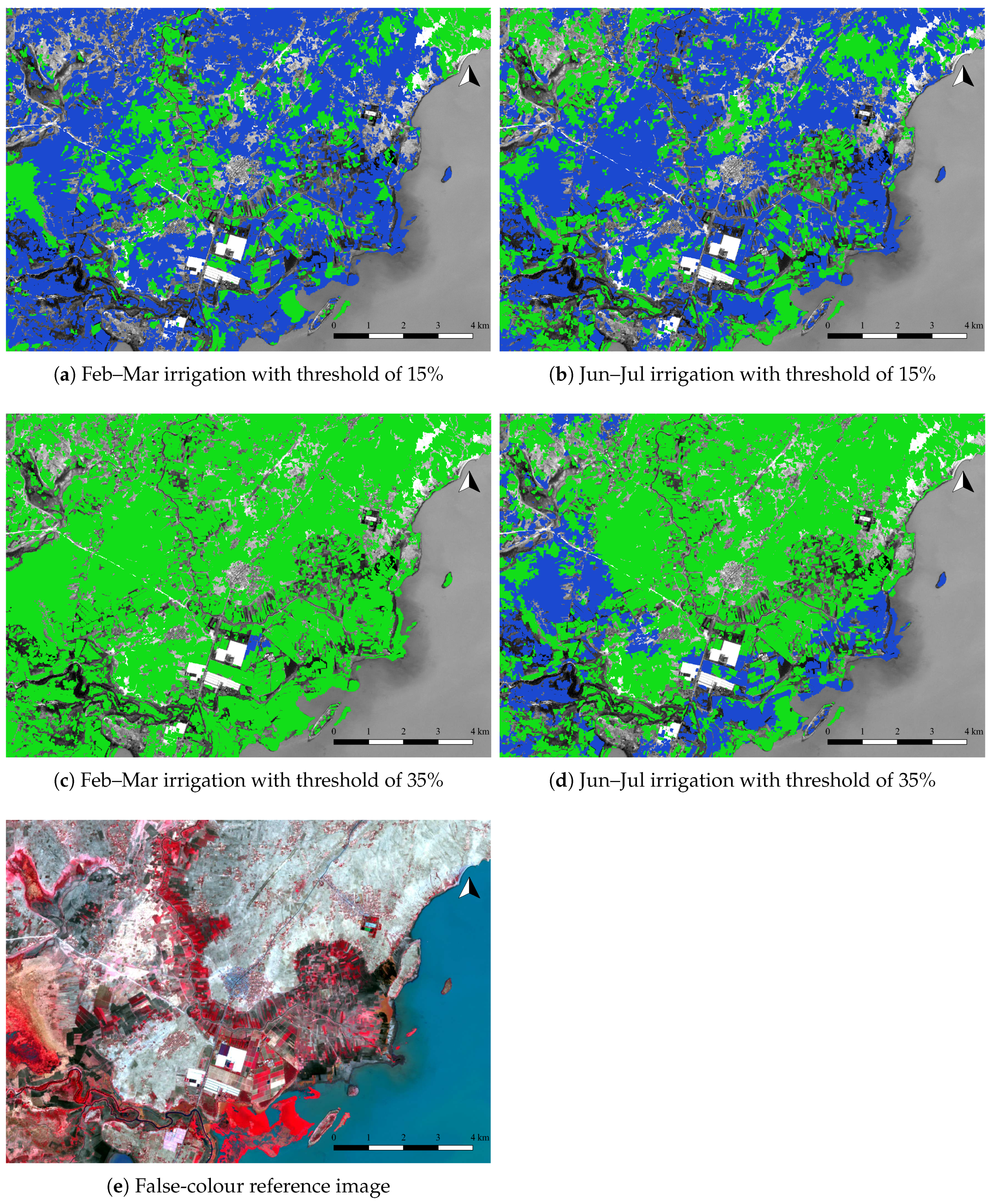
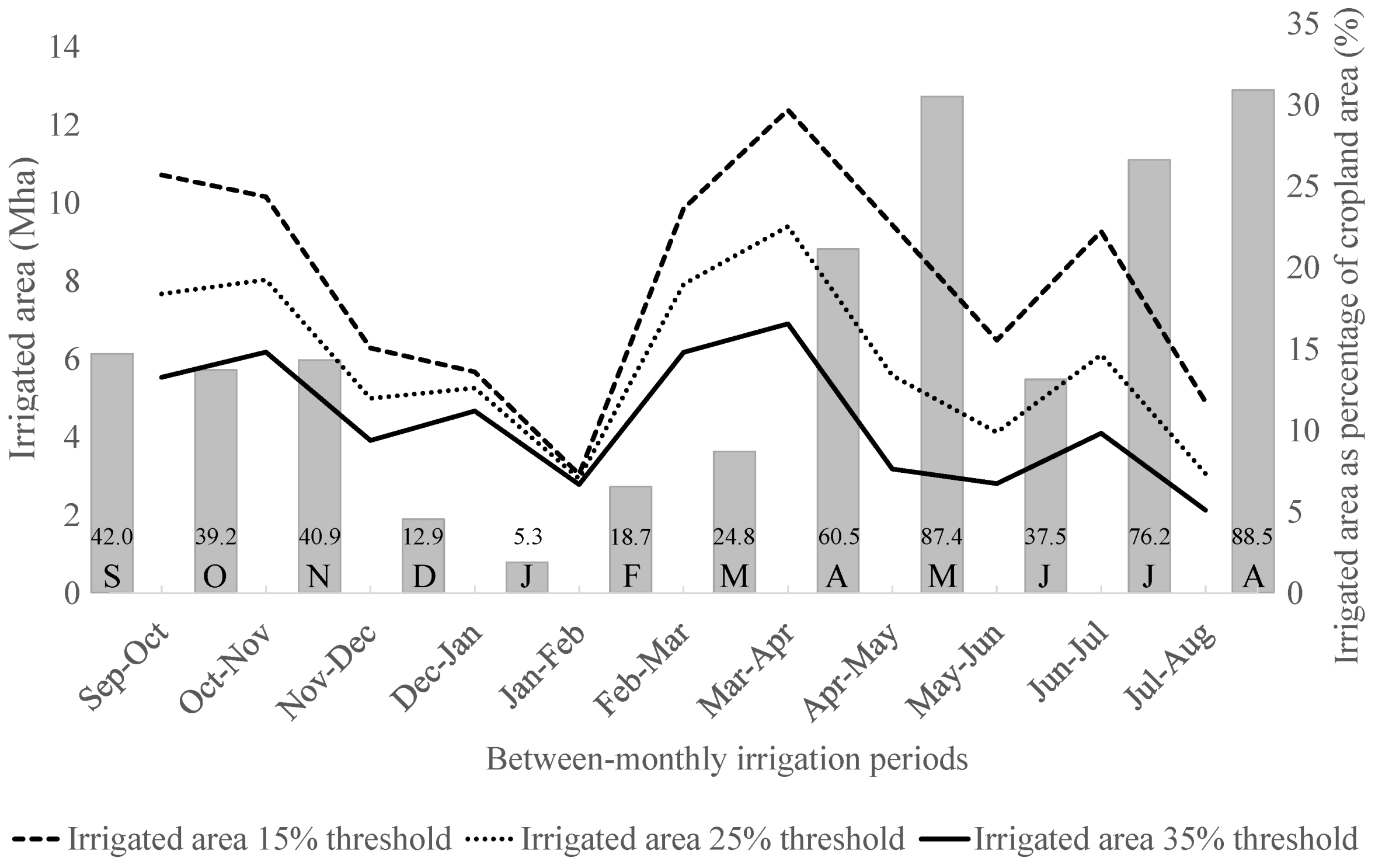

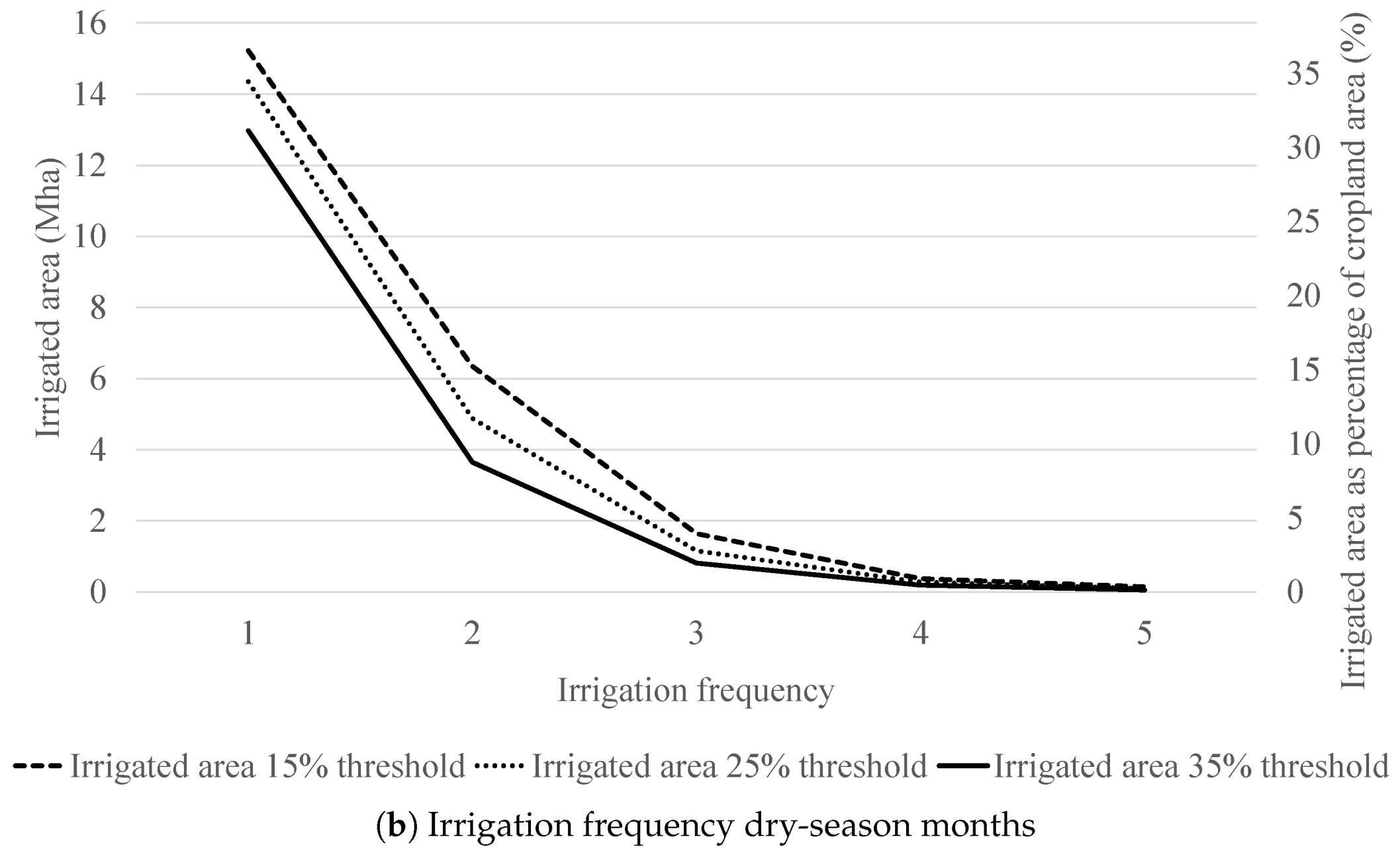
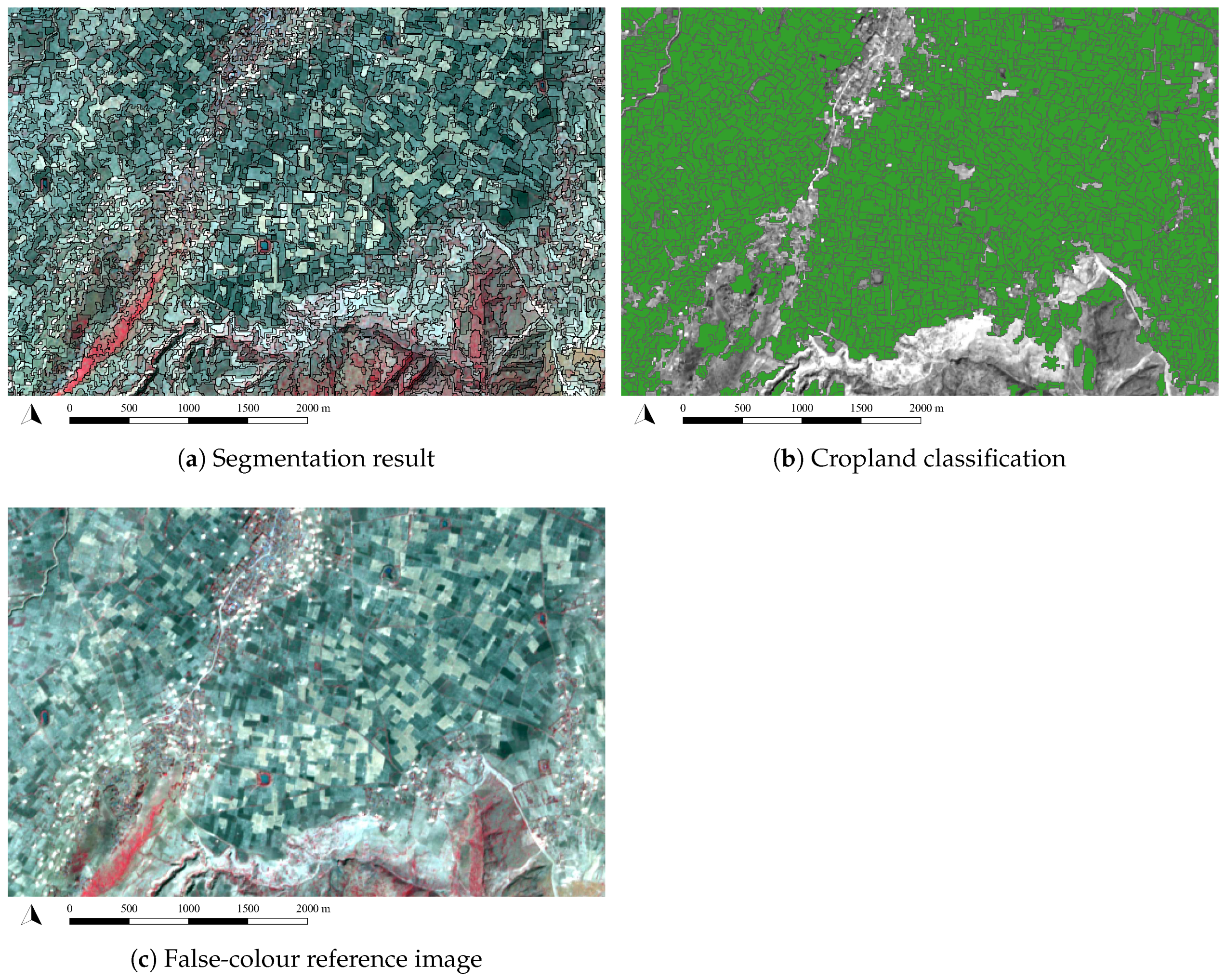
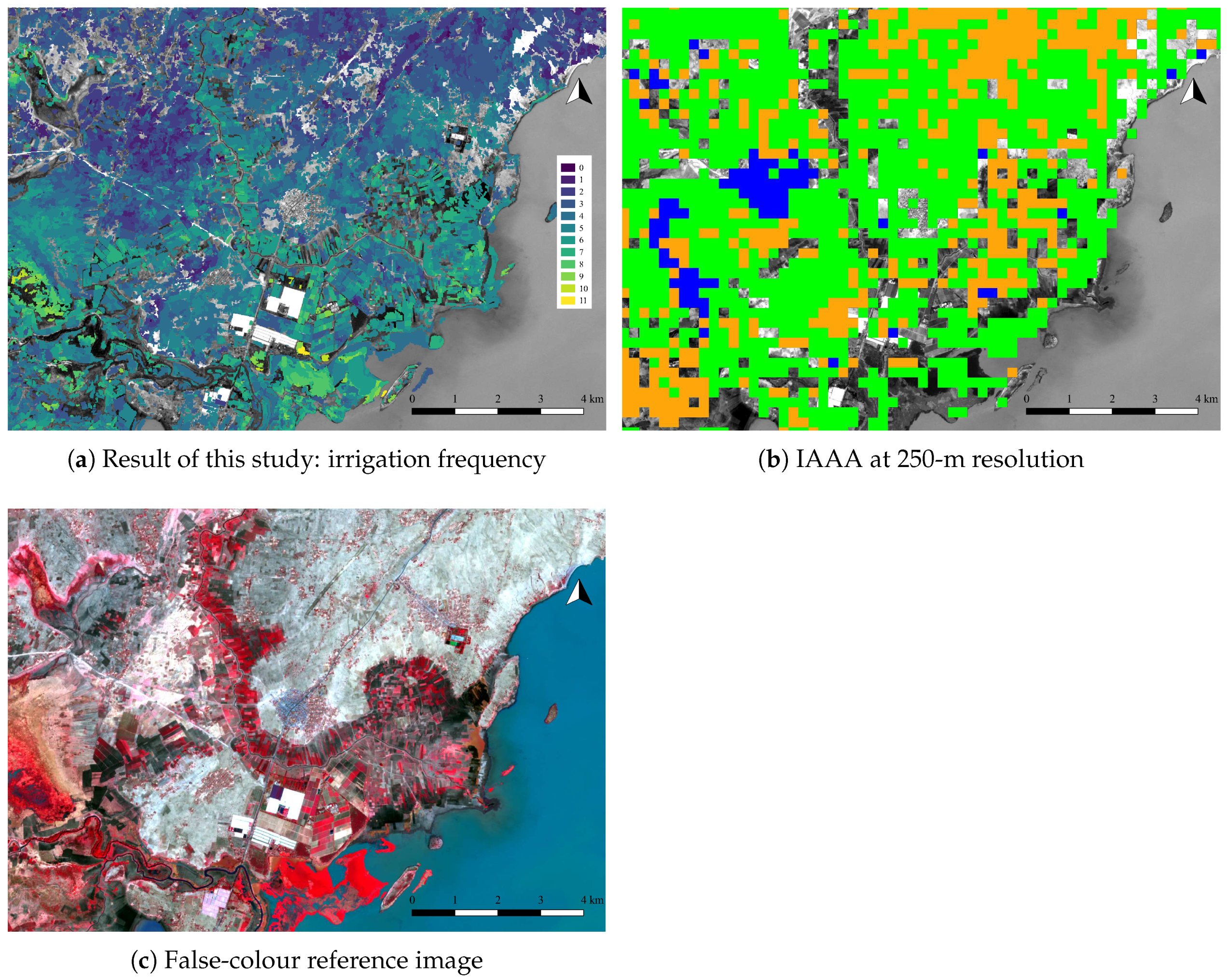
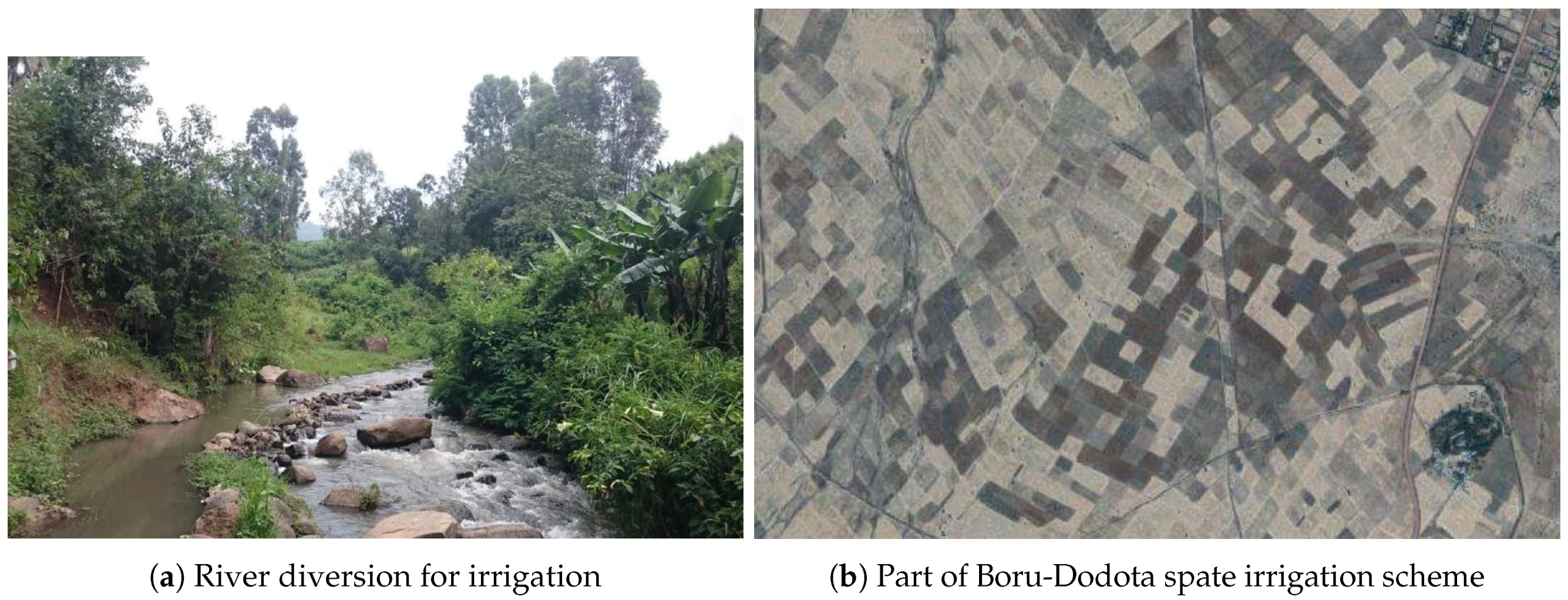
| Nr. of Objects | Cropland | Other LULC |
|---|---|---|
| Training on objects with complete NDVI time series | 5275 | 17,473 |
| Validation on objects with complete NDVI time series | 1319 | 4368 |
| Validation on objects with incomplete NDVI time series | 3038 | 12,854 |
| (A) All Validation Data | Observed | ||
|---|---|---|---|
| Predicted | Cropland | Other LULC | User’s acc. (%) |
| Cropland | 4927.74 | 1426.61 | 78 |
| Other LULC | 1885.2 | 84,945.24 | 98 |
| Producer’s acc. (%) | 72 | 98 | |
| Overall acc. (%) | 96 | ||
| Kappa coef. | 0.73 | ||
| Predicted | Cropland | Other LULC | User’s acc. (%) |
| Cropland | 2650.16 | 216.19 | 92 |
| Other LULC | 502.92 | 66,120.04 | 99 |
| Producer’s acc. (%) | 84 | 100 | |
| Overall acc. (%) | 99 | ||
| Kappa coef. | 0.88 | ||
| (C) Validation Data Incomplete NDVI Time Series | Observed | ||
| Predicted | Cropland | Other LULC | User’s acc. (%) |
| Cropland | 2277.58 | 1210.42 | 65 |
| Other LULC | 1382.28 | 18,825.2 | 93 |
| Producer’s acc. (%) | 62 | 94 | |
| Overall acc. (%) | 89 | ||
| Kappa coef. | 0.57 |
| (Irrigated) Cropland Products | Spatial Resolution (m) | Cropland (Mha) | Cropland as Percentage of Horn of Africa (%) | Irrigated Cropland (Mha) | Irrigated Cropland (All) as Percentage of Cropland Area in the Horn of Africa (%) | ||
|---|---|---|---|---|---|---|---|
| all | 1–2 | 3+ | |||||
| This study entire year 15% | 10 | 41.67 | 16.77 | 37.13 | 22.57 | 14.56 | 89.1 |
| This study entire year 25% | 10 | 41.67 | 16.77 | 32.87 | 24.44 | 8.43 | 78.88 |
| This study entire year 35% | 10 | 41.67 | 16.77 | 27.96 | 23.13 | 4.83 | 67.1 |
| This study dry season 15% | 10 | 41.67 | 16.77 | 23.72 | 21.57 | 2.15 | 56.92 |
| This study dry season 25% | 10 | 41.67 | 16.77 | 20.75 | 19.22 | 1.53 | 49.8 |
| This study dry season 35% | 10 | 41.67 | 16.77 | 17.67 | 16.62 | 1.06 | 42.41 |
| GFSAD30AFCE | 30 | 37.71 | 15.17 | - | - | - | - |
| GLC30 | 30 | 32.2 | 12.96 | - | - | - | - |
| GFSAD250 | 250 | 31.39 | 12.63 | not available | - | - | not available |
| IAAA | 250 | 50.94 | 20.5 | 8.17 (22.39) | - | - | 16.04 (53.74) |
| Globcover 2009 | 300 | 37.97 | 15.27 | 0.0004 | - | - | 0.01 |
| GRIPC | 500 | 22.08 | 8.89 | 1.15 | - | - | 5.21 |
| GFSAD1000 (GIAM) | 1000 | 38.26 | 15.4 | 9.93 | - | - | 25.95 |
| GMIA | 10,000 | - | - | 0.95 | - | - | - |
| AQUASTAT | variable | 24.41 | 9.82 | 1.23 (2.33) | - | - | 2.95 (9.55) |
© 2019 by the authors. Licensee MDPI, Basel, Switzerland. This article is an open access article distributed under the terms and conditions of the Creative Commons Attribution (CC BY) license (http://creativecommons.org/licenses/by/4.0/).
Share and Cite
Vogels, M.F.A.; de Jong, S.M.; Sterk, G.; Douma, H.; Addink, E.A. Spatio-Temporal Patterns of Smallholder Irrigated Agriculture in the Horn of Africa Using GEOBIA and Sentinel-2 Imagery. Remote Sens. 2019, 11, 143. https://doi.org/10.3390/rs11020143
Vogels MFA, de Jong SM, Sterk G, Douma H, Addink EA. Spatio-Temporal Patterns of Smallholder Irrigated Agriculture in the Horn of Africa Using GEOBIA and Sentinel-2 Imagery. Remote Sensing. 2019; 11(2):143. https://doi.org/10.3390/rs11020143
Chicago/Turabian StyleVogels, Marjolein F.A., Steven M. de Jong, Geert Sterk, Harke Douma, and Elisabeth A. Addink. 2019. "Spatio-Temporal Patterns of Smallholder Irrigated Agriculture in the Horn of Africa Using GEOBIA and Sentinel-2 Imagery" Remote Sensing 11, no. 2: 143. https://doi.org/10.3390/rs11020143
APA StyleVogels, M. F. A., de Jong, S. M., Sterk, G., Douma, H., & Addink, E. A. (2019). Spatio-Temporal Patterns of Smallholder Irrigated Agriculture in the Horn of Africa Using GEOBIA and Sentinel-2 Imagery. Remote Sensing, 11(2), 143. https://doi.org/10.3390/rs11020143





